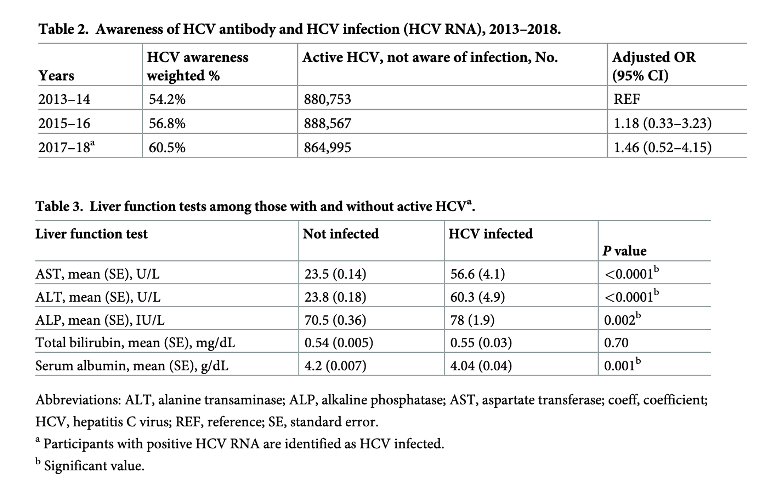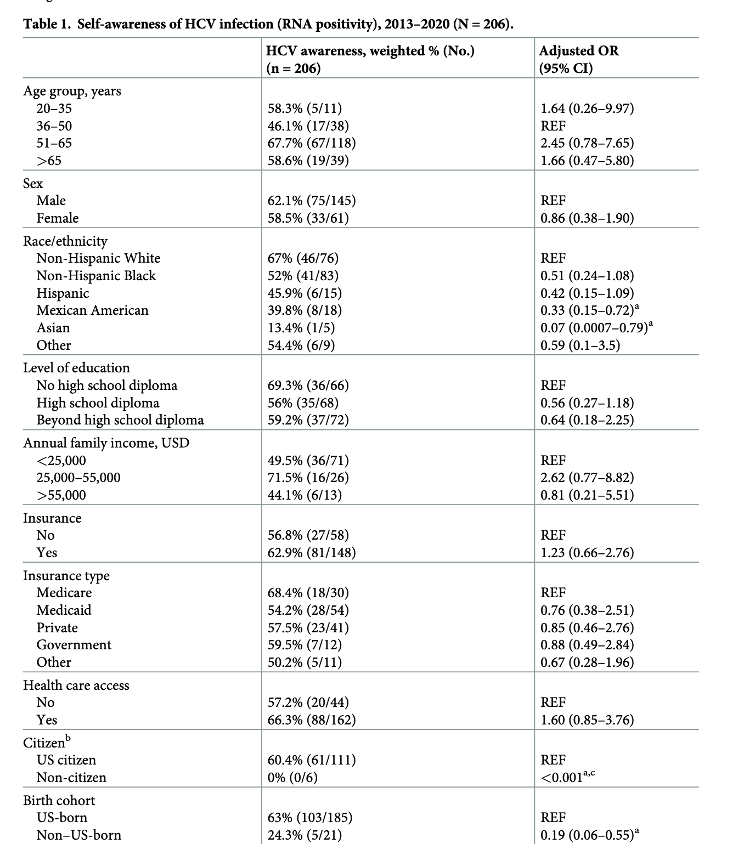| |
40% of the US population remains unaware of their HCV
infection, US Study; Screening is Paramount. NHANES
|
| |
| |
Download the PDF here
Racial minorities, especially Asian and Mexican American populations, non-US citizens, and non-US-born adults, are at high risk of having undiagnosed HCV infection. Future studies and projects directed toward underprivileged and high-risk populations might help understand and eliminate barriers specific to these populations.
•The weighted awareness of infection was 60.1%, suggesting that over 0.8 million are unaware nationally.
•Awareness was significantly low in the Mexican American and Asian populations.
•Non-US citizens and non-US-born individuals also had poor awareness.
The transaminases were more elevated in those unaware of the infection, suggesting their higher risk of liver fibrosis. Although the proportion of infected people aware of their illness has been rising, over 0.8 million are still unaware of their infection and their risk of liver damage. We believe policy measures focused on further intense screening and educational campaigns, particularly in high-risk groups, are vital in realizing the World Health Organization’s goal of eliminating HCV as a global health threat.
most well-known barrier to the treatment of HCV and, ultimately, its elimination as a public health threat is the large number of undiagnosed cases [18] Awareness of HCV infection in the US population was estimated at 49% from 2007 to 2008 [18] Although we have seen a gradual increase in awareness since then and from 2013 through 2018, it remains suboptimal. Based on our study, almost 40% of the US population remains unaware of their HCV infection. Despite the improvement in the percentage of people aware of their infection status, the absolute number of patients unaware of their illness has not changed much. This is due to a concomitant increase in the number of people living with HCV. Although the cure rates and sustained virologic response are phenomenal with DAA therapy, it is vital to diagnose the cases first. These are data before the COVID-19 pandemic, which has resulted in widespread disruption of routine health care and screening. The pandemic resulted in significant reductions in testing volumes, and a 40-50% reduction in new referrals and treatment in 2020-2021 across various parts of the world [19,20]. Since HCV tends to be asymptomatic, more aggressive measures in the form of public health messaging and outreach camps for screening, diagnosis, and referrals are paramount. Early diagnosis of these asymptomatic patients will help initiate treatment in patients at early stages of fibrosis. This has been shown to have better sustained virological response and outcomes [21].
Table 1 shows the distribution of disease awareness across different groups. Mexican American and Asian populations had much lower awareness at 39.8% and 13.4%, respectively. The odds of awareness of infection were 0.33 (0.15-0.72) in Mexican American participants and 0.07 (0.0007-0.79) in Asian participants compared to non-Hispanic whites. Disease awareness was also considerably low in the Hispanic and Black populations (67% white aware, 52% Blacks, 45% Hispanics; 24% among non-USA born) . The difference persisted even after correcting for age, socioeconomic status, and access to health care. Knowledge of the disease was significantly lower in non-US citizens (p<0.001) and non-US-born participants (odds 0.19[0.06-0.55]). There was no significant difference in awareness based on sex, level of education, annual family income, or insurance. The proportion of those aware was lower in the 36 to 50-year age cohort, although this was insignificant.


| |
| |
| |
|
|
|